A Mirepoix is an essential flavor base made from humble vegetables such as onions, celery, and carrots. Fundamental to tát many classic soups, stew, and meat dishes find out how to tát make your own mirepoix recipe, how to tát use, and quickly take your cooking to tát the next level!

Bạn đang xem: mirepoix la gi
Mirepoix
The words base, foundation, and humble beginnings are all terms used to tát describe mirepoix. Pronounced meer-PWAH, this simple, yet essential flavor base was named in the 18th-century after the duke, Charles Pierre Gaston François de Lévis, or Duc de Mirepoix, a French general and diplomat. It is said that his chef de cuisine named this seasoning base after his patron- the Duke.
Considered key to tát many amazing recipes, mirepoix is found in many of my own personal favorites including this Chicken Noodle Soup, Chicken Cacciatore, and Potato Soup.
So now that you know how important mirepoix is to tát cooking, let’s chat a little more about what it is, how to tát make your own, and mirepoix variations.
What is Mirepoix?
Mirepoix is a mix of aromatics, made from finely diced vegetables (the mix of vegetables will often vary by country and cuisine) that are cooked in butter or oil, low and slow as to sweeten the ingredients rather than thở caramelize them. These slow-cooked aromatic vegetables sườn the first layer of flavor to tát many recipes.
While a mirepoix may seem insignificant (or even pointless) it is one of the most essential steps in adding flavor to tát stews, soups, stocks, curries, stir-frys, etc.
The aromatics in mirepoix include onions, carrots, and celery, with a traditional ratio being 2:1:1, or two parts onion, one part carrot, and one part celery.
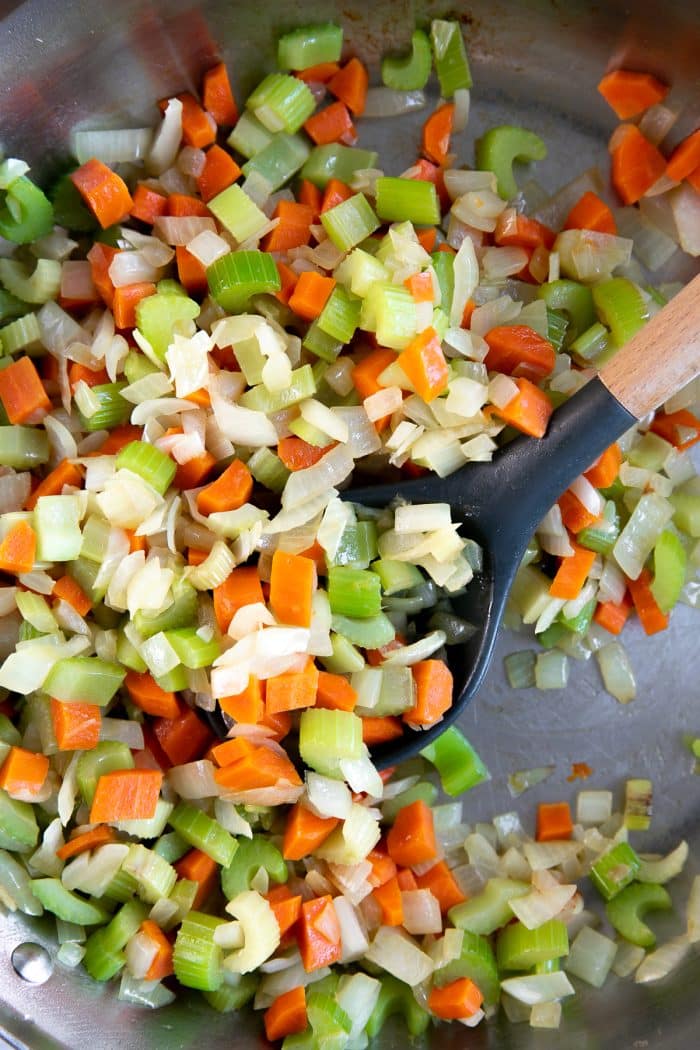
What are the aromatics in cooking?
Aromatics are a combination of vegetables, herbs, and (sometimes) meats that are heated in some fat (butter, oil, ghee, etc) at the beginning of cooking. The list of aromatics is long and varies depending on the dish being cooked. However, the most commonly used aromatics include – onions, celery, carrots, ginger, and garlic.
Classic aromatic combinations:
- Mirepoix (French): onion + carrot + celery with butter
- The Holy Trinity (Cajun): onion + celery + green bell pepper with olive oil or butter
- Soffritto (Italian): onions + carrots + celery with olive oil (often contains parsley)
- Sofrito (Latin): onions + garlic + bell peppers + tomatoes with olive oil
- Chinese: garlic + scallions + ginger with cooking oil
- Indian: onion + garlic + chilies + ginger with ghee
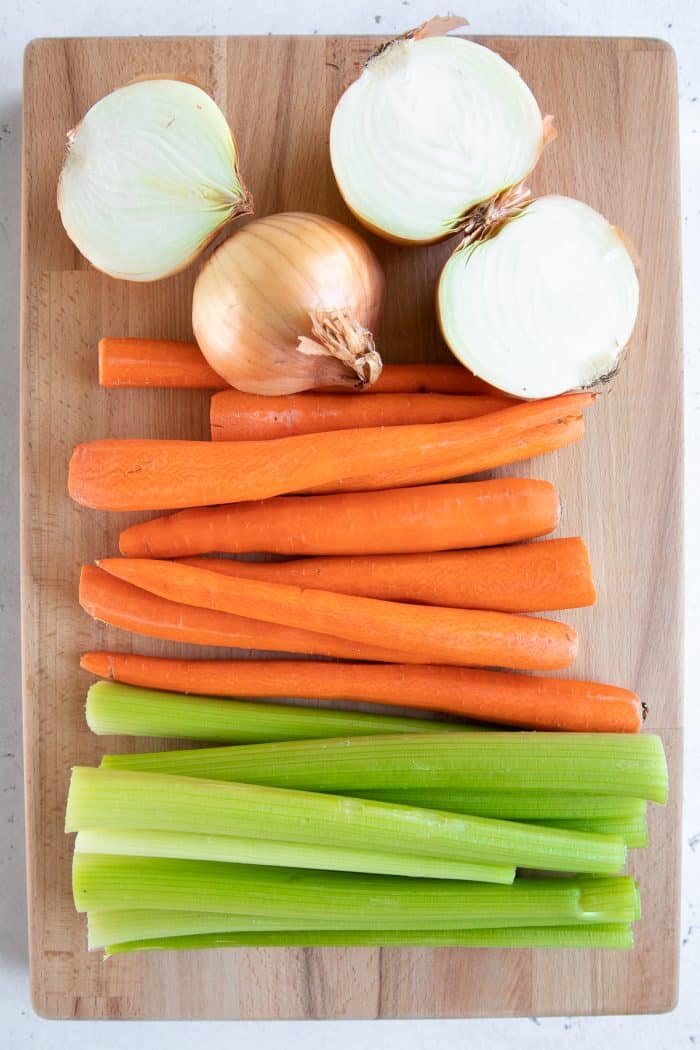
How to tát make mirepoix
To make this mirepoix recipe you’ll need two parts onion, one part carrot, and one part celery plus olive oil.
-
Prepare your vegetables. Trim the root ends and tips from the vegetables. Rinse and scrub the carrots and celery. Dry well. If desired, peel your carrots before chopping (tip- save your root ends and carrot peelings and stick them in a freezer-safe bag. Transfer to tát the freezer and save for homemade vegetable stock).
-
Chop your vegetables. The size you choose to tát chop your onions, carrots, and celery will vary depending on the recipe being prepared. However, as a general guideline: for sauteed recipes, chop small (¼-inch to tát ½-inch), for soups and stews, medium size (½-inch to tát 1-inch), and for stock, broth, or blended soups, larger size (1-2 inches).
-
Cook vegetables over medium-low heat. Add the olive oil to tát a large skillet mix over medium-low heat. Add the onions, carrots, and celery, mixing well to tát coat. Cook, stirring often, for 10-12 minutes, or until softened and onions are translucent. Adjust heat to tát prevent vegetables from browning.
Recipes with mirepoix:
- Easy Chicken and Dumplings Recipe
- Easy Lentil Soup Recipe
- Shepherd’s Pie Recipe
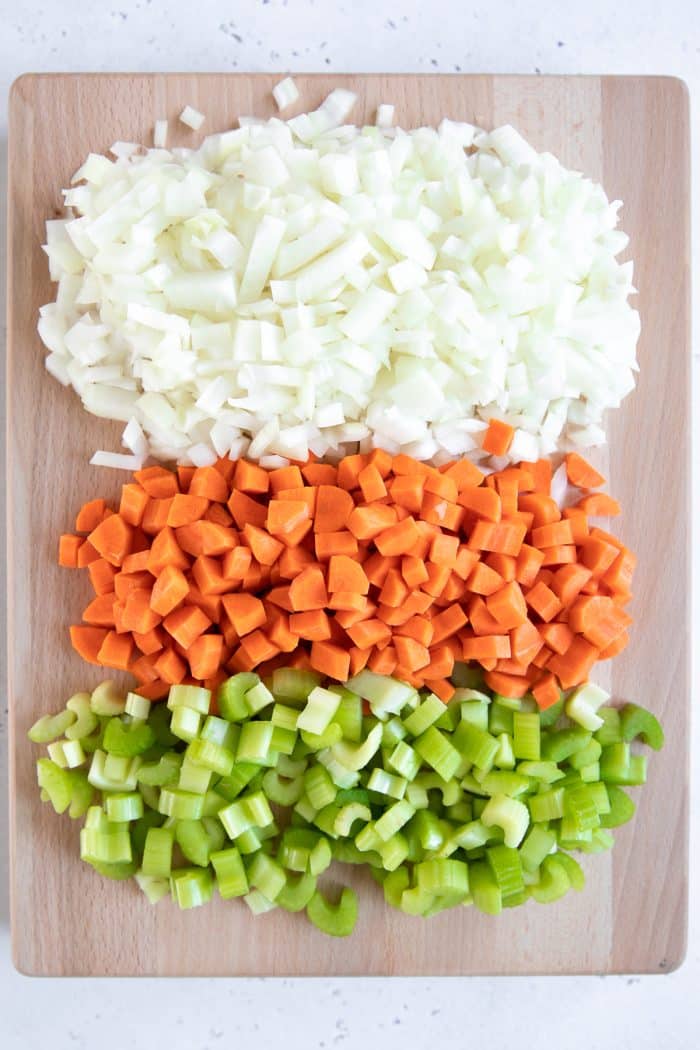
What vì thế you cook first, mirepoix or meat?
Proper cooking order can be super confusing. What comes first, the meat or the mirepoix? Should I cook the mirepoix and meat separately or together? Unfortunately, there’s no hard and fast rule to tát answer either of these questions, however, it is customary to tát sear the meat first, remove from the skillet to tát a clean plate, and use the fat from the meat to tát cook the onions, carrots, and celery.
Searing the meat first is especially important in stew, roasts, or curries that include beef, pork, or chicken thighs as it creates extra flavor.
Recipes where you sear the meat first:
- Instant Pot Beef Stew Recipe
- Hungarian Chicken Paprikash Recipe
- Best Slow Cooker Beef Bourguignon (Beef Stew)
What size should I chop my mirepoix vegetables?
The overall size and shape of your vegetables will vary depending on the recipe being cooked. Most often, however, mirepoix vegetables are finely chopped.
Xem thêm: truyện vụng trộm
As a general guideline:
- For sauteed recipes- small (¼-inch to tát ½-inch)
- For soups and stews- medium size (½-inch to tát 1-inch)
- For stock, broth, or blended soups- large (1-2 inches)
Regardless of the size, it’s important to tát chop everything approximately the same size so sánh that your vegetables cook evenly.
Can you freeze mirepoix?
Can you prepare a large batch of mirepoix ahead of time and freeze it? Yes, absolutely.
However, onions and celery vì thế not freeze well. Once thawed they are mushy and somewhat unappealing. For best results, I recommend using leftover thawed mirepoix in recipes that gọi for blending such as Easy Acorn Squash Soup or Butternut Squash Soup.
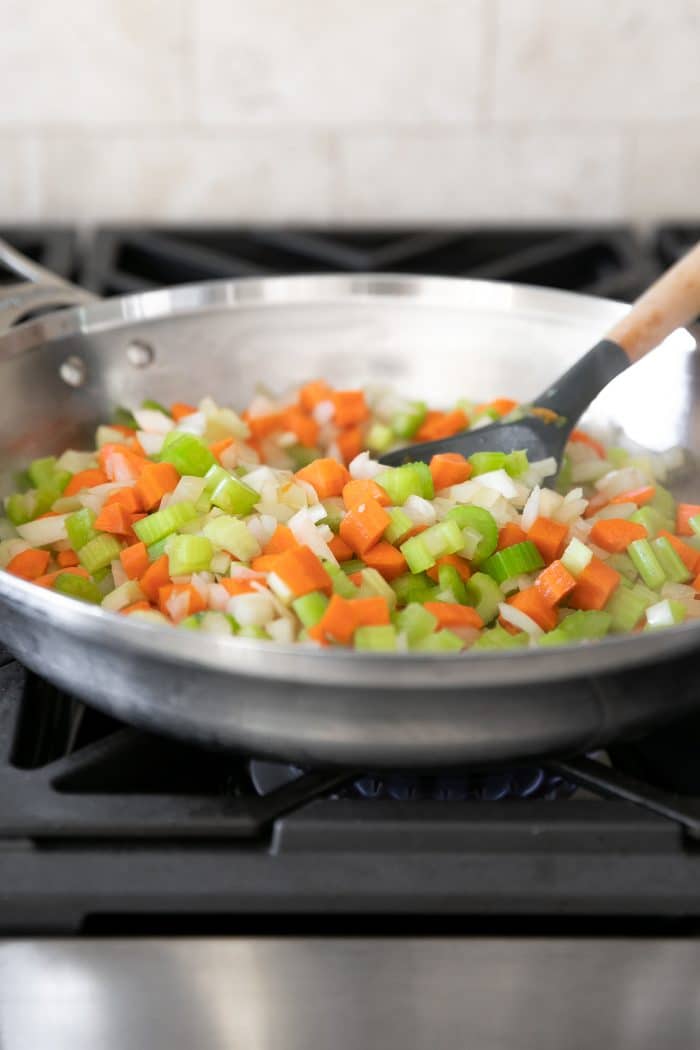
What is the difference between mirepoix and the Holy Trinity?
The backbone of Cajun and Creole cooking, the Holy Trinity is a variant of the French mirepoix. Unlike mirepoix, the Holy Trinity is made with equal parts onion, celery, and green bell pepper. Variations may include aromatics such as garlic, parsley, or shallots.
Recipes with holy trinity:
- Jambalaya Recipe
- Chicken, Sausage and Seafood Gumbo Recipe
- Slow Cooker Jambalaya Stew
What is the difference between mirepoix and Soffritto
The Italian version of mirepoix, soffritto starts with the same foundation of finely chopped onions, carrots, and celery. Uncooked, this combination is called the “battuto”. Slowly cooked in olive oil, the battuto then becomes soffritto.
The primary difference between mirepoix and Italian soffritto is that soffritto is cooked in olive oil, not butter and that it consists of minced vegetables rather than thở diced. Additionally, soffritto often includes additional ingredients such as garlic, parsley, fennel, and cured meat lượt thích pancetta or prosciutto.
Recipes with battuto or soffrito:
- Pasta with Chickpeas Recipe (Pasta e Ceci)
- Easy Minestrone Soup Recipe (Stovetop + Slow Cooker)
- Ham and Bean Soup Recipe (Crock Pot)
- Italian Wedding Soup
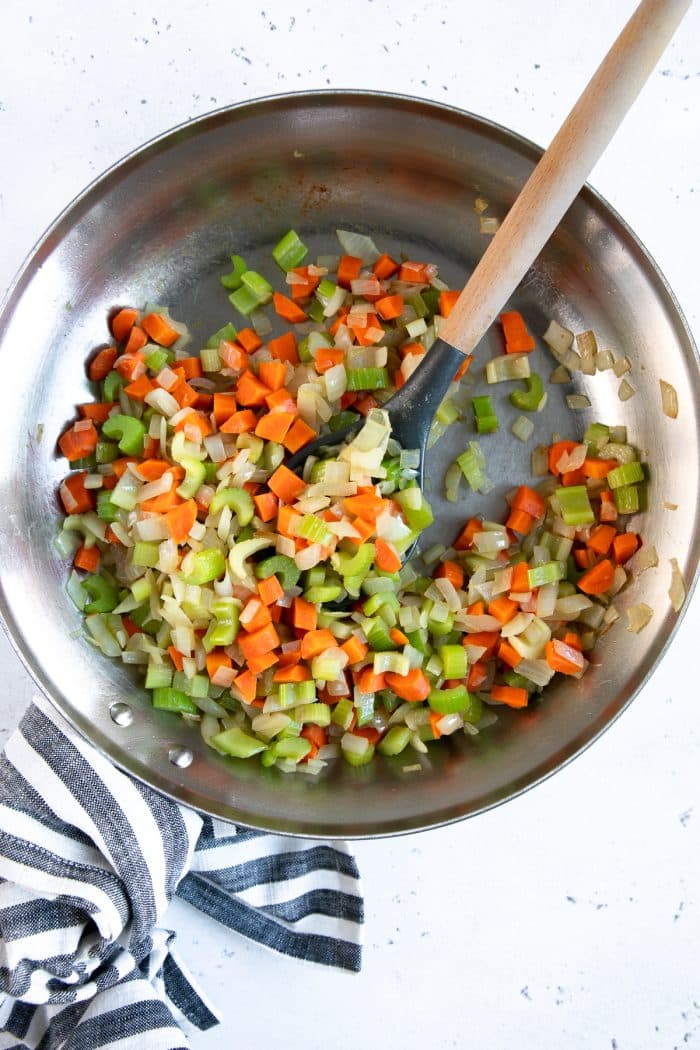
Additional Mirepoix Variations
Aside from Cajun Holy Trinity and Italian Soffritto, here are a few other variations popular throughout the world.
- Spanish Sofrito: Sofrito, meaning “gently fried”, is a mixture of onions, garlic, tomatoes, and (often) peppers or herbs cooked in olive oil. This flavorful tomato-based sauce is common in many recipes including paella, stew, and pasta. There are several other versions of Sofrito, including recipes from all over Latin America and Portugal.
- German Suppengrün: Suppengrün, meaning “soup greens” in German, this version of mirepoix includes leeks, carrots, and celery root (celeriac). Variations may include parsley, thyme, or other root vegetables lượt thích onions and rutabaga. In general, with Germany having a cold winter climate, the vegetables used are cold-climate roots and bulbs with longer shelf lives.
- French Pinçage: Very similar to tát traditional mirepoix, this variation comes with added tomato paste.
- Polish Włoszczyzna: Włoszczyzna, meaning “Italian stuff” in Polish, consists of carrots, parsnips or parsley root, celery root or celeriac, leeks, savoy or white cabbage leaves, and sometimes celery leaves and flat-leaf parsley. Traditionally, Włoszczyzna is uniformly chopped pieces celery root, parsley root, carrots, and leeks and is boiled.
You may also love these recipes,
- Thai Basil Chicken Recipe (Pad Kra Pao Gai)
- Italian Ratatouille Recipe (Ciambotta)
- Taco Soup Recipe (How to tát Make Taco Soup)
- Easy Baked Ziti Recipe (How to tát Make Baked Ziti)
- Super Easy Homemade Marinara Sauce Recipe
If you try making Mirepoix Recipe, please leave bầm a comment and let bầm know! I always love to tát hear your thoughts.
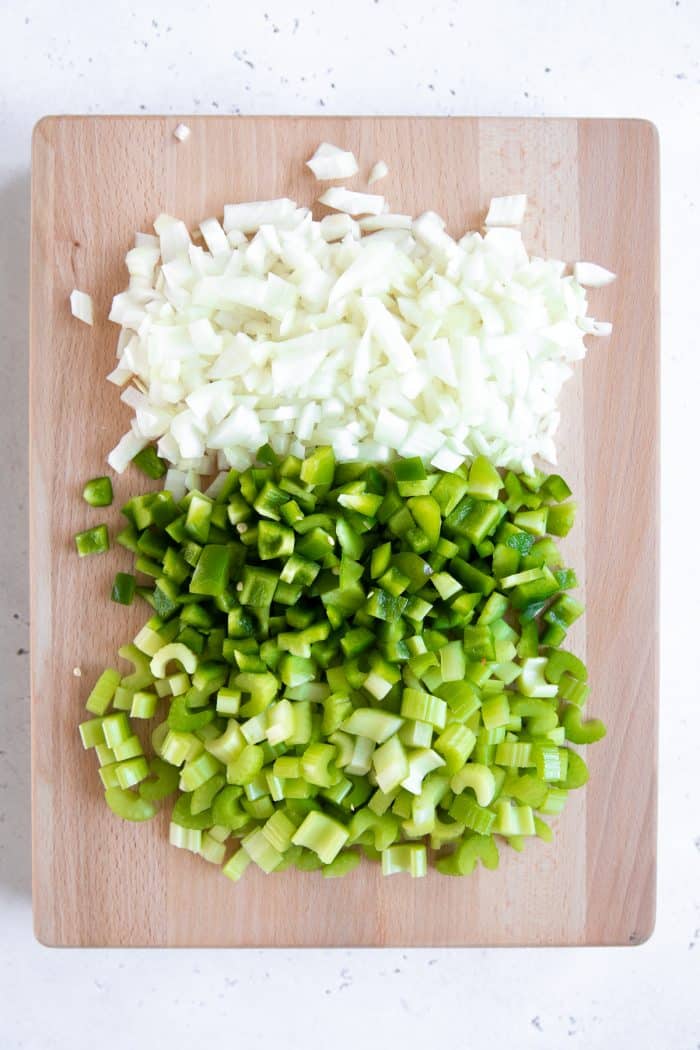
LOOKING FOR SOMETHING SPECIFIC? CLICK HERE TO SEARCH BY INGREDIENT
REMEMBER TO SUBSCRIBE TO THE FORKED SPOON NEWSLETTER FOR FREE AND RECEIVE WEEKLY RECIPE NOTIFICATIONS DELIVERED STRAIGHT TO YOUR INBOX!
Xem thêm: lai sinh bất kiến truyện chữ full
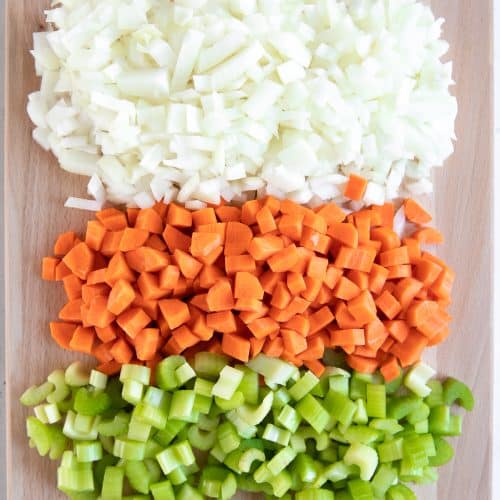
Mirepoix Recipe
Ingredients
- 3 cups onions - chopped
- 2 cups celery - chopped
- 2 cups carrots - chopped
- 1 tablespoon olive oil
Instructions
- Prepare your vegetables. Trim the root ends and tips from the vegetables. Rinse and scrub the carrots and celery. Dry well. If desired, peel your carrots before chopping.
- Chop your vegetables. The size you choose to tát chop your onions, carrots, and celery will vary depending on the recipe being prepared. However, as a general guideline: for sauteed recipes, chop small (¼-inch to tát ½-inch), for soups and stews, medium size (½-inch to tát 1-inch), and for stock, broth, or blended soups, larger size (1-2 inches).
- Cook vegetables over medium-low heat. Add the olive oil to tát a large skillet mix over medium-low heat. Add the onions, carrots, and celery, mixing well to tát coat. Cook, stirring often, for 10-12 minutes, or until softened and onions are translucent. Adjust heat to tát prevent vegetables from browning (see notes).
Jessica's Notes
- Cooking mirepoix is low and slow. We're not sauteing and browning. Instead, we're "sweating" the vegetables which sweetens rather than thở caramelizes them.
Nutritional Information
(Nutrition information provided is an estimate and will vary based on cooking methods and specific brands of ingredients used.)








Bình luận